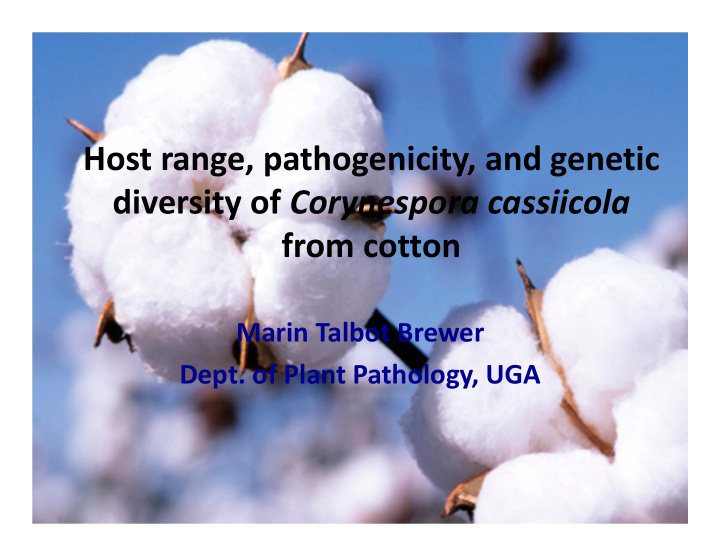



Host range, pathogenicity, and genetic diversity of Corynespora cassiicola from cotton Marin Talbot Brewer Dept. of Plant Pathology, UGA
Corynespora cassiicola is causing numerous emerging diseases, including target spot of cotton A disease is emerging if – increase in host range, geographic range, or incidence is observed, or – new strains evolve
Causes of disease emergence include… • Pathogen adaptation • Pathogen introduction • Host susceptibility • Environmental change Target spot on cotton (photo: Nick McGhee) Which of these explain emergence of target spot on cotton?
Corynespora cassiicola has a very wide host range Pathogen of crop plants, ornamentals, and weeds rubber tree, hydrangea, mandevilla, cassava, lantana, – balsam pear, basil, highbush blueberry, papaya, eggplant, azalea, cocoa, sweet potato cotton, soybean, tomato, cucumber, cowpea, pepper, bean – Cassiicolin ‐ host selective plant toxin Endophyte Saprophyte Subcutaneous skin infections, corneal infections
Population biology of C. cassiicola • Few studies addressing population biology • Dixon et al. (2009) most comprehensive study to date • Sequenced 4 genes from 143 isolates from different hosts and geographic locations • 50 isolates on 8 economically important hosts – Basil, bean, papaya, tomato, cowpea, cucumber, soybean, sweet potato
Host range and phylogenetic diversity • Phylogenetic lineages – wide geographic range – wide host range • Some host specialization • No cotton isolates, 2 soybean isolates Dixon et. al (2009) Phytopathology
Research Objectives 1. Determine the host range of C. cassiicola isolates from cotton and pathogenicity of isolates from other hosts in the southeastern USA to cotton 2. Determine the phylogenetic relationship of isolates of C. cassiicola from cotton with isolates from other hosts 3. Characterize the genetic diversity of C. cassiicola isolates from cotton
Why is this important? Host range • – Identify alternative hosts of cotton isolates – Identify sources of inoculum – Determine if different populations exist in SE Phylogenetic relationships • – Determine where it came from – Identify other potential hosts – Identify if specialization exists Diversity of cotton isolates • – Determine if there are differences in aggressiveness, host range, fungicide resistance – Develop a panel for resistance assays, breeding – Identify mechanisms of dispersal – Understand why it emerged
Research approach • Isolate collection – Diverse hosts in southeast – Diverse geographic locations (SE and worldwide) – Focus on cotton and soybean isolates
Host range • Inoculate cotton seedlings with diverse isolates – Resistant and sensitive cotton cultivars • Inoculate diverse hosts with cotton isolates – Soybean, cowpea, cucumber, tomato seedlings • 40 isolates, 10 each from cotton and soybean • Evaluate for symptoms
Phylogenetic relationships • Cotton isolates (100) – Diverse varieties – Diverse geographic regions • Soybean isolates • Other isolates from southeastern US • 150 total isolates • Sequence 4+ genes • Construct phylogenetic trees • Lineages to which cotton, soybean and other hosts belong • Clustering?
Genetic diversity • Sequence 6 genes for numerous cotton isolates throughout southeastern US • Also from other countries where C. cassiicola on cotton found
Summary • Corynespora cassiicola is an emerging disease • Wide host range with some specialization • Research on cotton and soybean populations is needed • Research will provide insight into where it came from, why it is emerging, and diversity of cotton populations • Knowledge will improve disease management • Alternative hosts • Sources of inoculum • Resistance
Recommend
More recommend